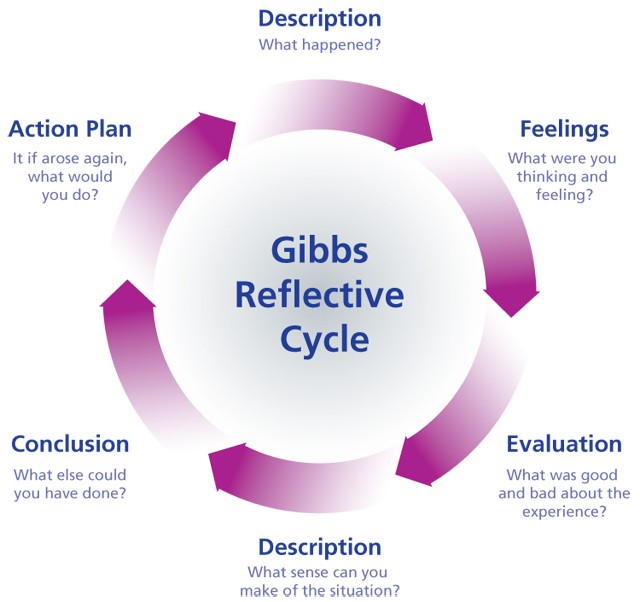Working from Home: The Creative Challenges of Solo Videography

I have always considered filmmaking to be a collaborative process. In my freelance work, solo projects are very rare as I am usually working with a second shooter. However, my work with Humanity Cosmetics has been entirely independent. The style of product videography I have been learning requires no actors, and I am responsible for all elements of content production from the comfort of home (Fig. 1). Working with products as subjects has been difficult, as I have struggled to create interesting content without models. I quickly realised the responsibility in having full creative control. My biggest challenge has been to animate Humanity Cosmetics’ products without actors, bringing them to life to reflect the brand aesthetic. This blog post will evaluate my experience using Gibbs’ Reflective Cycle (1988) (Fig. 2) for learning outcomes which I will take into future work.

Earlier this year, I planned a video for Chris (CEO of Humanity Cosmetics) based on a collection of inspiring cosmetic advertisements I found online. HC’s aesthetic is one of luxury and masculinity, which I considered when developing my shot-list. The concept was centred around a young professional getting ready for his first day at a new job. While Chris appreciated my regard for HC’s values, he explained to me the company’s need for mood-focused product content on their Tik-Tok and Instagram reels rather than brand videos. Nelson-Field et al write (2013, 211), ‘delivering content that elicits a strong emotional reaction should be the main aim of content generators, regardless of the valence of the message.’ I understood this position and changed my approach. There were problems with my first product video, which I produced before my ‘first day’ concept. Chris commented that the video didn’t match the brand aesthetic, and after review, it was clear that the colours used did not complement the colour scheme of the product. After Chris’ guidance, I have paid more attention to detail in my content, keeping aesthetic at the forefront of my mind.
I was disappointed when Chris rejected my plan as I was excited about the idea. But the project was too big to execute alone, and he knew this. I had developed a few ideas with the other students on the placement. We considered working as a crew to split the workload on each of the videos we planned, but Chris advised we work individually. Given my limited experience and resources, I realised the planning that would be needed for my idea was not worth the payoff from Chris’ perspective, and producing short videos instead was more logical. However, I knew I had a large skill-gap to overcome. The idea of creating content without narrative or actors was daunting, especially after my unsuccessful first attempt.
I learned from my second project that success in product videography depends on a careful balance between planning and experimentation. I have found it difficult to plan these videos due to the lack of action and narrative. But what I’ve found to be essential is a basic shot list and a clear concept that reflects the brand aesthetic. In creating my second video I went into production without a clear plan. This was useful in retrospect, as the lack of planning allowed me to be less restrictive and experiment with possibilities for future videos. However, without direction I quickly became frustrated. I was bursting with ideas but had no technical plan for achieving them.
Chris’ advice against working with actors posed learning opportunities which have greatly benefitted my videography skills. Without relying on acting performance, I have become more resourceful, making use of props, setting and lighting to create compositions which reflect the brand aesthetic of Humanity Cosmetics. Producing my second video without a plan was a major technical challenge. My goal was to display HC’s moisturiser with a sense of elegance and luxury. After my unsuccessful first attempt I wanted this video to feel more masculine, so I implemented a muted colour scheme. (Fig. 3 and 4). I struggled most with lighting. The reflective nature of HC’s products created hard shadows and bright reflections which I had not encountered before, being accustomed to lighting people (Fig. 5). Fixing this required trial and error by adjusting camera and lighting positions. Above all, creating product-focused content has developed my understanding of cinematography. Without acting performance, I have needed to pay more attention to visual design to convey mood.



After Chris’ direction not to use actors in my videos, I felt lost. I believed I lacked the resources and skill necessary to create quality content and felt an overwhelming sense of responsibility. I was unsure how to plan these videos, so relied heavily on experimentation. This spontaneous approach was useful as I quickly learned by failure which techniques worked and which didn’t, letting me filter my approach and plan more effectively for the next content batch. But in retrospect, I was inefficient. The time I spent testing techniques slowed the production of usable material. I didn’t think pre-production was as necessary in product videography as it is in collaborative projects, but this is untrue. As a result, my videos have been formulaic, sharing similar patterns and lacking originality. I have realised that a simple but effective concept is essential for short videos and should serve as a blueprint for shots. Lui et al argue (2019) that when enterprises use short video, they should integrate their brand’s culture with content they expect their audience to find entertaining.
I will produce one final batch of content for Chris: a 20 second video and a collection of stills. I will focus on developing an interesting concept which is relevant to Humanity Cosmetics’ audience and reflects the brand aesthetic. I will plan a shot list for the video, decide which resources I will make use of, and compose a few photographs that share the aesthetic of the video. I now have the confidence to carry out an ambitious project that I can use as a calling card for future clients.
Bibliography
Gibbs, Graham. (1988) Learning by Doing: A Guide to Teaching and Learning Methods. Oxford: Oxford Polytechnic.
Liu, Gao-fu, et al (2019) ‘Research on the influence of social media short video marketing on consumer brand attitude.’ 2019 5th International Conference on Social Science and Higher Education (ICSSHE 2019). Atlantis Press
Nelson-Field, K., Riebe, E., & Newstead, K (2013) ‘The Emotions that Drive Viral Video’ Australasian Marketing Journal, Vol. 21, No. 4, pp. 205–211. https://doi.org/10.1016/j.ausmj.2013.07.003
You May Also Like

Interview a New You! – Becoming an Interview Guru
24 February 2023
“Fake it ‘til you make it!”: Finding Success in a Simulated Interview
22 February 2023

